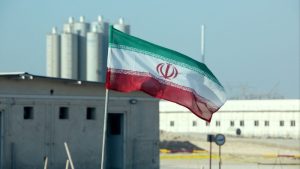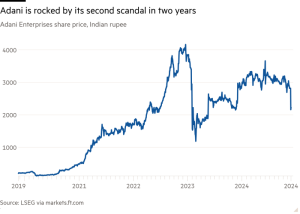what became of Labour’s Green Prosperity Plan
This article is an on-site version of our Inside Politics newsletter. Subscribers can sign up here to get the newsletter delivered every weekday. If you’re not a subscriber, you can still receive the newsletter free for 30 days
Good morning. Westminster is still trying to digest the news of Donald Trump’s victory in the US election. Keir Starmer has issued a “hearty” congratulations to the president-elect, but there are multiple fronts where the incoming Washington administration will be at odds with London: here’s our guide to those areas of friction.
Inside Politics is edited by Georgina Quach. Read the previous edition of the newsletter here. Please send gossip, thoughts and feedback to [email protected]
What survives of the GPP
One of the casualties of Trump’s return is likely to be the Democrats’ “Inflation Reduction Act”, a gargantuan piece of legislation designed to spark a gold rush into American cleantech.
“My plan will terminate the Green New Deal, which I call the Green New Scam. Greatest scam in history, probably,” Trump said in September. “We will rescind all unspent funds under the misnamed Inflation Reduction Act.”
Closer to home I wondered what happened to the “Green Prosperity Plan”, which was meant to be Labour party’s own version of this.
It wasn’t so long ago that Labour described the GPP as its big economic idea. “Labour’s Green Prosperity Plan is the vehicle through which we will turn Britain’s economy around,” said one slogan.

But since Keir Starmer won the general election in July, the phrase has fallen into abeyance.
That’s not to say that Labour has dropped the green energy chat. Far from it.
The drive to decarbonise the electricity system by 2030 is one of the defining missions of the new government. (Clean energy was mentioned no fewer than eight times in the King’s Speech.)
But I’m curious — in a nerdy way — about what happened to the language and the mechanics of the thing that used to be the Green Prosperity Plan.
I’ve gone back through the big speeches from the Labour conference in September to see whether Starmer, Rachel Reeves or Ed Miliband used the phrase. They didn’t.
So what happened?
Until February, the GPP had an eye-watering price tag of £28bn a year, all funded by borrowing. Rewind to last winter and a genuine scrap was taking place inside the shadow cabinet about the size of the green package.
There were those — somewhat to the left in Labour terms — such as Miliband, Louise Haigh and Sue Gray (remember her) who wanted to keep it.
And then there were the likes of Rachel Reeves and Pat McFadden and Morgan McSweeney (somewhat to the right in Labour terms) who wanted to rein in the scale and scope of the GPP to avoid lethal headlines and Tory attacks.
Some shadow ministers wondered why the borrowing was only for green infrastructure rather than for new schools or hospitals or prisons.
Throughout that long three-month period, the Labour press machine dishonestly insisted no such debate was going on.
Starmer prevaricated for weeks on end until he made his mind up.
The volte-face, when it came, was brutal. It involved Starmer and Reeves briefing a bunch of journalists off-camera in a parliamentary room (yes I was there) that the plan would be cut from £140bn over five years to, er, £24bn.
“As conditions change, you adjust your position,” Starmer told the hacks. Interest rates were zero when the policy was first cooked up. Now they were close to 5 per cent.
And so a scheme which had been similar on scale in GDP/head terms to the huge IRA of Joe Biden (remember him) was slashed to barely a sixth of its original size.
Three existing elements of the plan survived.
-
There would still be a state-owned energy company called GB Energy, costing a one-off £8.3bn over a five-year parliament, to co-invest in renewable energy schemes.
-
There would still be a £7.3bn “national wealth fund” to invest in the decarbonisation of heavy industry.
-
There would still be a national insulation scheme called the “Warm Homes Plan”, but it would be slashed from £6bn a year to just over £1.3bn a year.
Despite this humiliating U-turn, the Green Prosperity Plan continued to be a major Labour slogan in the run-up to the July election. It was still there in the manifesto document: “At the heart of our approach will be our Green Prosperity Plan”.
And then the phrase disappeared from use.
Green energy, energy independence, clean energy, carbon capture are still a major part of the new government’s political narrative. Starmer has staked much of his reputation on hitting the 2030 electricity decarbonisation target despite industry thinking it’s stretching to the point of being virtually impossible.
So, to some extent, the ditching of the specific phrase “Green Prosperity Plan” is a question of semantics.
Ask the Labour party what happened and they will say the language changed in favour of a new, more jazzy phrase: “Clean Energy Superpower”.
And yes, that line was used in Miliband’s conference speech and by the prime minister elsewhere. It was Miliband’s team which came up with the “superpower” language because they thought it sounded more pro-growth and more pro-investment.
It also played into the feedback from polling firms that “energy independence” is a line which gets traction with the public.
A Trump retreat from the green agenda could — if anything — give impetus to Europe’s attempts to attract low-carbon investment.
So far so clear. But what has happened in recent weeks to the three constituent parts of what used to be the GPP?
Great British Energy
Ministers still insist that GB Energy will get £8bn of cash over the current five-year parliament, mostly to co-invest in private renewable energy schemes.
But the new state-owned energy company will receive just £100mn in funding for renewables projects — and £25mn of seed capital to establish the company — in the first two years of this parliament, according to last week’s Budget.
Labour says that the details of more funding will follow in next year’s multiyear spending review. But the Association for Renewable Energy and Clean Technology said it was “disappointed” there wasn’t more initial funding.
National Wealth Fund
The National Wealth Fund was meant to be a new, standalone body which would help heavy industry decarbonise.
That’s not what happened. Instead Labour has simply rebranded the UK Infrastructure Bank (set up by Rishi Sunak three years ago) as the National Wealth Fund and promised it some extra cash.
Rachel Reeves has quietly cut by a fifth the new money she is investing into the NWF from £7.3bn to £5.8bn.
The Treasury says the missing £1.5bn would still be spent on priority areas. Steel is the obvious one.
Warm Homes
Rachel Reeves used her Budget to announce £3.4bn for the government’s “warm homes” insulation programme over three years.
The £3.4bn allocation is equivalent to £1.1bn a year. That seems lower than the annual £1.3bn for insulation that Labour promised back in February.
Government aides say more money will be set out at next year’s spending round covering 2026/7 and 2027/8.
Campaigners say it won’t be clear until then whether Labour will fulfil their previous pledge to spend £13.2bn on energy efficiency over this parliament.
(That is roughly a doubling of the £6bn the previous Conservative administration had hoped they would spend over the same timeframe.)
One final aside
The original premise of the prosperity plan was — you’ll remember — to borrow £28bn a year for low-carbon schemes.
Last week, Reeves unveiled a big rise in taxes, but also a jump in borrowing of £32bn a year, equal to 1 per cent of GDP.
That extra borrowing for capital expenditure will now be distributed right across government priorities rather than the net zero transition.
And yet that figure seems too close to be a total coincidence.
Now try this
For some of us, Wednesday was excruciating.
Yes, I tore a muscle playing 5-a-side football and am now housebound. Soothing me through the discomfort is Patterns in Repeat, the beautiful new album by singer-songwriter Laura Marling, who did a superb string of gigs at Hackney Church last week. Our pop critic gave it 4/5 in this review.
Have a lovely weekend.
Top stories today
Recommended newsletters for you
White House Watch — Your essential guide to what the 2024 election means for Washington and the world. Sign up here
One Must-Read — Remarkable journalism you won’t want to miss. Sign up here
#Labours #Green #Prosperity #Plan






